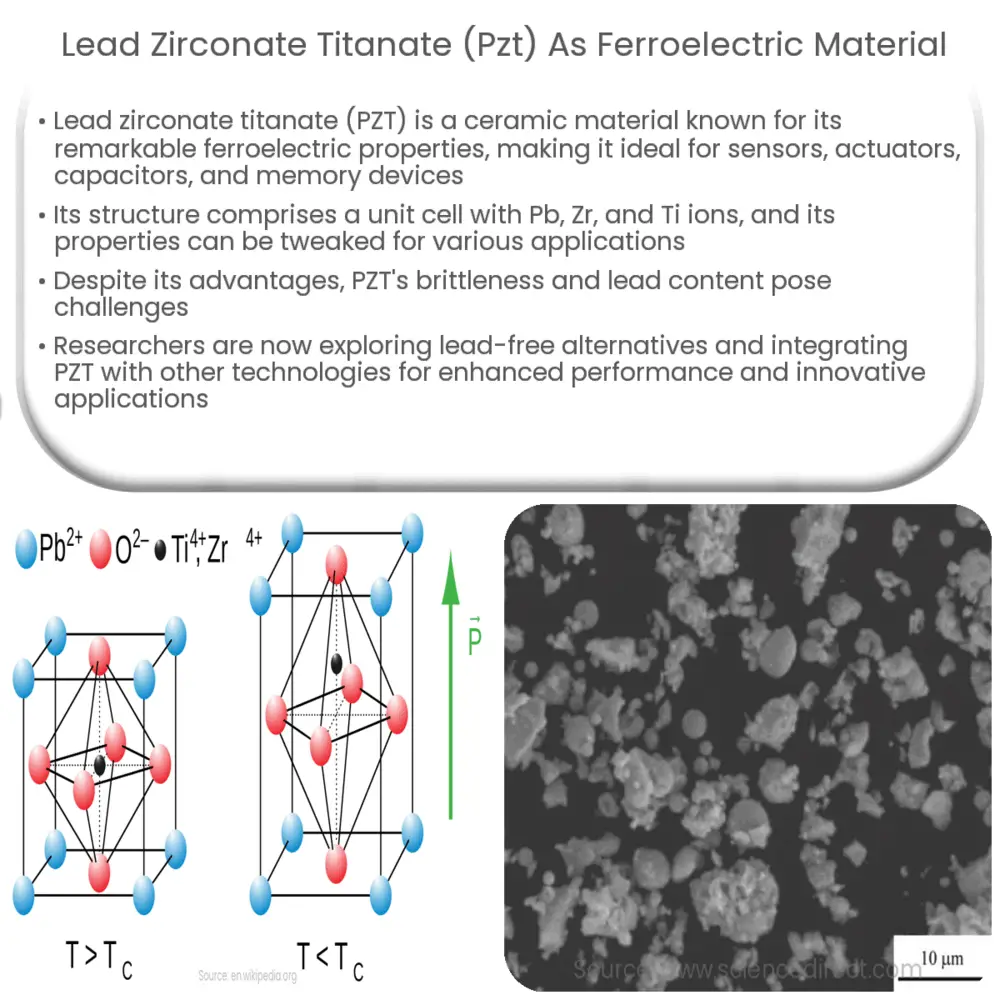Explore lead zirconate titanate (PZT), a versatile ferroelectric material used in sensors, actuators, capacitors, and memory devices.

Lead Zirconate Titanate (PZT) as Ferroelectric Material
Introduction
Lead zirconate titanate (Pb(Zr,Ti)O3), commonly referred to as PZT, is a ceramic material that has gained significant attention due to its excellent ferroelectric properties. Ferroelectric materials exhibit a spontaneous electric polarization that can be reversed by an applied electric field. PZT’s unique characteristics make it an ideal material for numerous applications, ranging from sensors and actuators to capacitors and memory devices.
Structure and Properties
PZT is a perovskite-structured material, which consists of a unit cell that contains a large A-site cation (Pb2+), a B-site cation (either Zr4+ or Ti4+), and three oxygen atoms (O2-). The Pb, Zr, and Ti ions can be substituted with other elements, enabling researchers to modify the material’s properties to suit various applications. The ratio of Zr to Ti in the PZT composition influences the material’s ferroelectric properties, with the morphotropic phase boundary (MPB) providing the best balance between ferroelectric and piezoelectric properties.
The ferroelectric properties of PZT arise from the displacement of the central B-site cation (Zr or Ti) relative to the oxygen octahedra. This displacement results in a dipole moment and the formation of electric domains within the material. The spontaneous polarization of these domains can be reversed by an external electric field, a property that is key to many applications of PZT.
Applications
Thanks to its exceptional ferroelectric properties, PZT has found use in a wide variety of applications. Some of the most prominent uses include:
- Sensors and Actuators: PZT’s piezoelectric properties make it a popular choice for sensors and actuators. The material can convert mechanical stress into an electrical signal (sensing) or electrical energy into mechanical movement (actuation). PZT is commonly used in ultrasonic transducers, pressure sensors, and accelerometers.
- Capacitors: The high dielectric constant and large polarization of PZT make it an attractive material for capacitors, particularly in high-frequency applications. PZT-based capacitors exhibit lower dielectric loss and higher energy storage density compared to traditional ceramic capacitors.
- Non-Volatile Memory Devices: PZT’s ferroelectric properties enable the development of non-volatile memory devices that retain data even when power is lost. Ferroelectric random access memory (FeRAM) is one such technology that uses PZT thin films to store data in the form of electric polarization states.
In summary, lead zirconate titanate (PZT) is a versatile ferroelectric material that has been utilized in a wide array of applications. Its unique properties, such as high dielectric constant, spontaneous polarization, and piezoelectricity, make it an attractive choice for engineers and researchers working in the fields of sensing, actuation, energy storage, and data storage.
Challenges and Future Developments
Despite the numerous advantages of PZT, there are certain challenges that need to be addressed to further enhance its performance and applicability. One such challenge is the material’s inherent brittleness, which can lead to mechanical failure in devices subjected to high stress or harsh operating conditions. Additionally, PZT contains lead, which poses environmental and health risks due to its toxicity. This has led to regulatory restrictions on the use of lead-containing materials in certain applications and regions.
Researchers are actively exploring alternative lead-free ferroelectric materials, such as barium titanate (BTO) and potassium sodium niobate (KNN), to address these concerns. While these materials exhibit promising ferroelectric properties, they have yet to match the performance of PZT in terms of piezoelectric coefficients and temperature stability. Ongoing research aims to improve the properties of lead-free materials through compositional modifications, doping, and optimizing fabrication processes.
Integration with Other Technologies
Another exciting development in the field of PZT is its integration with other materials and technologies. Researchers are exploring the potential of combining PZT with other functional materials, such as semiconductors and polymers, to create novel devices with enhanced performance and unique functionalities. For example, PZT-semiconductor heterostructures can be used to develop highly efficient energy harvesting systems that convert waste mechanical energy into electricity.
Similarly, the integration of PZT with flexible substrates or polymers can lead to the development of flexible and wearable electronic devices. These devices can conform to complex shapes and surfaces, enabling new applications in the fields of robotics, wearable electronics, and soft actuators. Flexible PZT-based sensors and energy harvesters can also find applications in structural health monitoring and self-powered wireless sensors.
Conclusion
Lead zirconate titanate (PZT) has established itself as a prominent ferroelectric material, thanks to its exceptional properties and versatility. Its widespread use in sensors, actuators, capacitors, and memory devices is a testament to its importance in modern technology. As research continues to address the challenges posed by the material’s brittleness and lead content, and as novel lead-free materials are developed, PZT’s role in the field of ferroelectric materials is expected to evolve. Furthermore, the integration of PZT with other materials and technologies will continue to drive innovation and enable new applications in areas such as energy harvesting, wearable electronics, and structural health monitoring.

